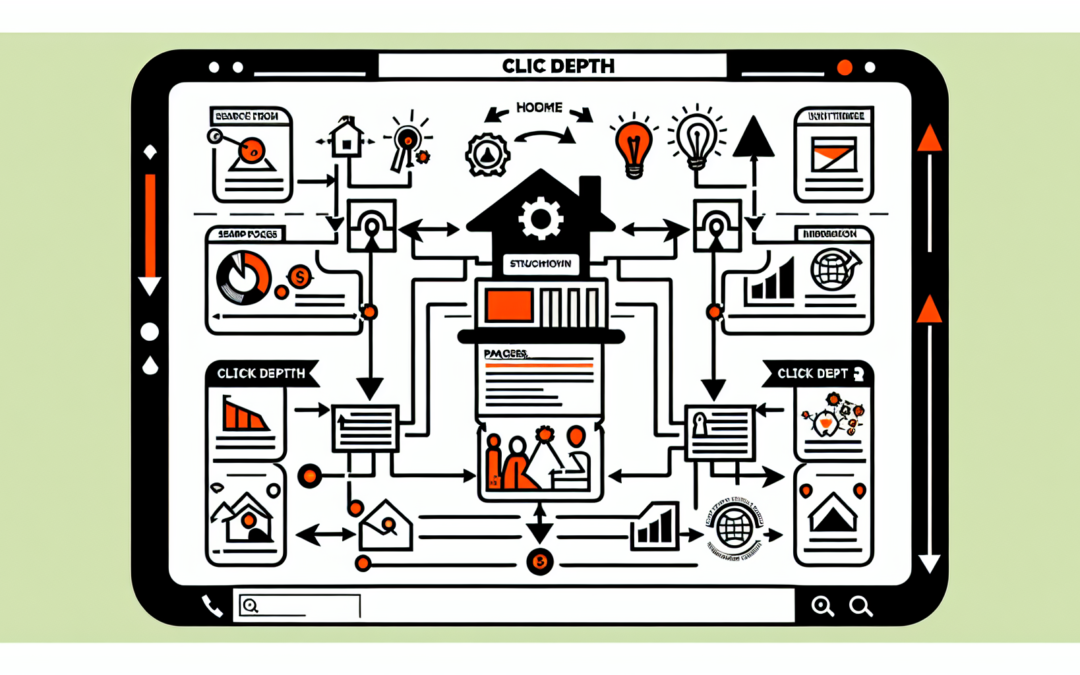Have you ever wondered about the importance of click depth in relation to SEO? Click depth refers to the number of clicks it takes for a user to reach a particular page on a website from its homepage. Understanding the significance of click depth can provide valuable insights into improving your website’s visibility and search engine rankings. By optimizing click depth, you can enhance user experience, increase the discoverability of your content, and ultimately drive more organic traffic to your site. So, let’s explore why click depth matters in the realm of SEO and how you can leverage it to your advantage.

What is Click Depth?
Click depth refers to the number of clicks it takes for a user to reach a specific page on a website from its homepage. In other words, it measures the level of navigation required to access a particular piece of content or information on a website. A shallow click depth means that the desired page can be reached in just a few clicks, while a deep click depth indicates that it takes multiple clicks to reach the desired destination.
Importance of Click Depth for SEO
Higher Ranking on Search Engine Results Pages
Click depth plays a crucial role in determining the ranking of a website on search engine results pages (SERPs). Search engines like Google prioritize websites that provide a seamless user experience, and one of the factors they consider is click depth. Websites with a shallow click depth tend to have a higher chance of ranking well in SERPs because they offer easy access to content, making it more likely for users to engage with the website.
Improved User Experience
Having a shallow click depth significantly improves the overall user experience. When users can access the desired information or content quickly and easily, they are more likely to stay on the website, explore more pages, and engage with the content. A positive user experience helps build trust, increases user satisfaction, and encourages users to return to the website in the future.
Increased Website Traffic
Optimizing click depth can lead to increased website traffic. When users can easily navigate through a website and find relevant information, they are more likely to spend more time exploring different pages. This increased website engagement can lead to higher organic traffic as search engines recognize the website’s value and relevance, potentially increasing the website’s visibility in search results.
Effective Indexing of Web Pages
A shallow click depth allows search engine bots to effectively crawl and index web pages. When web pages are easily accessible with fewer clicks, search engine bots can navigate through the website more efficiently and index the pages more thoroughly. This enhances the chances of all web pages being discovered and included in search engine indexes, increasing the website’s overall visibility.
Factors Affecting Click Depth
Website Structure and Navigation
The structure and navigation of a website have a significant impact on click depth. A well-organized and intuitive website structure makes it easier for users to find the information they are looking for. A clear hierarchy, with important pages prominently placed, can reduce the click depth required to access essential content and improve the overall user experience.
Internal Linking Strategy
The internal linking strategy of a website also influences click depth. By strategically placing relevant internal links throughout the website, users can easily navigate between related pages. Internal links help distribute link equity across different pages and improve the overall accessibility of content, reducing the click depth required to reach important pages.

Best Practices for Click Depth Optimization
Clear and Intuitive Website Architecture
To optimize click depth, it is vital to have a clear and intuitive website architecture. This means organizing the website’s content in a logical and hierarchical manner, with essential pages easily accessible from the homepage. Designing a user-friendly navigation menu and incorporating prominent calls-to-action can further simplify the user’s journey and reduce the click depth.
Reduce the Number of Clicks to Important Pages
Identify the most important pages on your website and aim to reduce the number of clicks required to reach them. By placing important content closer to the homepage or including them in the navigation menu, you can decrease the click depth and improve the overall user experience. Remember, the easier it is for users to access valuable content, the more likely they are to engage with it.
Utilize Breadcrumbs
Breadcrumbs are a navigational aid that shows users the path they have taken to reach a specific page. By incorporating breadcrumbs into your website design, you provide users with contextual information about their location within the site’s structure. Breadcrumbs act as visual cues, enabling users to understand their journey and easily navigate back to previous pages, which can reduce click depth.
Optimize Internal Linking
Strategically optimize internal linking within your website to reduce click depth and improve user experience. Ensure that relevant pages are internally linked to each other, especially from high-traffic pages or landing pages. By including appropriate anchor text and using descriptive linking, you can guide users to related content and keep them engaged within your website, ultimately decreasing click depth.
Measuring and Analyzing Click Depth
Tracking Tools and Analytics
To measure click depth, you can rely on tracking tools and analytics solutions. These tools provide valuable insights into user behavior and navigation patterns on your website. By tracking the number of clicks it takes for users to reach specific pages, you can identify areas of improvement and assess the effectiveness of your click depth optimization strategies.
Interpreting Click Depth Data
Analyzing click depth data allows you to gain a deeper understanding of how users interact with your website. Look for trends and patterns in click depth across different pages and sections of your website. Identify pages with a high click depth and determine possible reasons for the increased navigation requirements. This analysis can help you identify areas for improvement to enhance user experience.
Identifying and Addressing High Click Depth Pages
Using the click depth data, identify pages with a high click depth and focus on reducing the navigation steps required to reach them. Evaluate the website structure and navigation path leading to these pages. Consider restructuring the website, including relevant internal links, and adjusting the prominence of these pages to ensure they are easily accessible and decrease the click depth for users.
Click Depth and Mobile Optimization
Mobile-Friendly Design and Usability
With the increasing use of mobile devices, optimizing click depth for mobile users is essential. A mobile-friendly design ensures that the website’s structure is accessible and user-friendly on smaller screens. Elements such as navigation menus, buttons, and links should be appropriately sized and easily clickable to provide a seamless browsing experience, reducing the click depth for mobile users.
Responsive Web Design
Implementing a responsive web design ensures that your website adapts to different screen sizes and devices. A responsive design optimizes click depth by automatically adjusting the layout and structure of the website based on the user’s device. This eliminates the need for separate mobile and desktop versions of the website, providing a consistent user experience across all devices.
Accelerated Mobile Pages (AMP)
Implementing Accelerated Mobile Pages (AMP) can further optimize click depth for mobile users. AMP is a framework that focuses on providing faster and streamlined mobile web experiences. By implementing AMP, you reduce load times and eliminate unnecessary elements, improving the overall user experience and minimizing click depth, especially for mobile users with slower internet connections.
Common Click Depth Mistakes to Avoid
Orphan Pages
Orphan pages are pages on a website that do not have any internal links pointing to them. They are not connected to the website’s structure and are difficult for users and search engines to discover. To avoid orphan pages and potential high click depth, ensure that all important pages are properly linked within the website, allowing users to access them easily.
Excessive Click Depth Levels
Excessive click depth levels can frustrate users and hinder their ability to find relevant information. Aim to keep the click depth levels to a minimum, especially for important pages. The more clicks it takes for users to access valuable content, the higher the chance they may abandon the website and seek information elsewhere. Streamline navigation paths and reduce unnecessary levels of click depth.
Irrelevant or Broken Links
Irrelevant or broken links can disrupt the user’s navigation journey and increase click depth unintentionally. It is important to regularly review internal links and ensure their relevance and accuracy. Remove or update broken links to prevent users from encountering dead ends. By providing users with relevant and functioning links, you can optimize click depth and enhance the overall user experience.
The Future of Click Depth in SEO
Voice Search and Virtual Assistants
As voice search and virtual assistants gain popularity, the role of click depth in SEO will evolve. With voice search, users expect direct and concise answers for their queries, reducing the need for multiple clicks to access relevant information. Optimizing click depth for voice search involves providing clear and structured content that can be easily accessed and understood by virtual assistants.
User Intent and Contextual Search
In the future, search engines will increasingly focus on understanding user intent and delivering more contextually relevant search results. Click depth will play a role in this evolution by helping search engines identify websites that provide the best user experience. Websites with a shallow click depth that efficiently satisfy user intent are likely to receive higher rankings and increased visibility in search results.
Conclusion
Click depth is a critical aspect of SEO that influences website rankings, user experience, and overall website performance. By optimizing click depth through clear website architecture, intuitive navigation, and strategic internal linking, you can enhance user satisfaction, increase website traffic, and improve the visibility of your web pages on search engine results pages. As technology continues to evolve, it is essential to stay mindful of emerging trends, such as mobile optimization and voice search, to ensure that click depth remains a valuable factor in SEO success.


